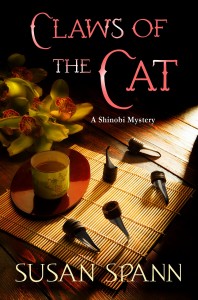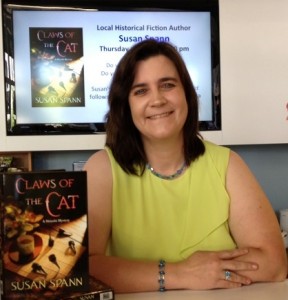Interview with Susan Spann, Author of “Claws of the Cat”
It is my very great pleasure today to welcome friend and fellow historical fiction writer Susan Spann to the blog. Susan’s debut historical mystery Claws of the Cat released in in July.
First a blurb to tantalize you:
May 1564: When a samurai is brutally murdered in a Kyoto teahouse, master ninja Hiro has no desire to get involved. But the beautiful entertainer accused of the crime enlists the help of Father Mateo, the Portuguese Jesuit Hiro is sworn to protect, leaving the master shinobi with just three days to find the killer in order to save the girl and the priest from execution.
enlists the help of Father Mateo, the Portuguese Jesuit Hiro is sworn to protect, leaving the master shinobi with just three days to find the killer in order to save the girl and the priest from execution.
The investigation plunges Hiro and Father Mateo into the dangerous waters of Kyoto’s floating world, where they learn that everyone from the elusive teahouse owner to the dead man’s dishonored brother has a motive to keep the samurai’s death a mystery. A rare murder weapon favored by ninja assassins, a female samurai warrior, and a hidden affair leave Hiro with too many suspects and far too little time. Worse, the ninja’s investigation uncovers a host of secrets that threaten not only Father Mateo and the teahouse, but the very future of Japan.
And now some questions to take you behind cover-copy (and it’s no exaggeration to say Susan reveals some thing here she has never told readers before):
1. What inspired you to choose a 16th century ninja master as your main character and detective?
In spring, 2011, while getting ready for work one morning, I actually heard a voice in my head say “Most ninjas commit murders, but Hiro Hattori solves them.” I knew immediately that this was a character—and a story—I had to write. I’ve loved Japanese culture since my college days, and loved the idea of writing a ninja detective.
2. Do you speak Japanese or have any personal connection to the country, its history and/or culture?
I speak a little Japanese (my Chinese is better) and I studied Japanese language, history, and culture for my undergraduate degree in Asian Studies from Tufts University. I’m also a fan, and lifelong student, of Japanese art and architecture.
3. I am always impressed by authors who can manage to plot out historical mysteries—it seems like laying an extra level of complexity on an already complex genre. Why a mystery as opposed to a straight historical?
Because I love to murder my imaginary friends.
Also, I find the complexities of a mystery allow me to use the history in unusual and interesting ways. For example, I get to translate modern forensics as seen through the eyes of a 16th century ninja assassin. I need to know what killed the victim, and how, but I also need to see the crime as Hiro would have seen it. The historian in me loves the opportunity to see the world through medieval eyes. The mystery lover in me … well, that gets us back to murdering imaginary friends.
4. Besides Hiro Hattori, who is your favorite character in Claws of the Cat? Who is your least favorite? Why?
This is one of the hardest questions I’ve been asked. I love all of my characters, for different reasons. I think my favorite, other than Hiro, would have to be Father Mateo—though he wasn’t my second-favorite from the start. He earned a place in my heart as I wrote the initial draft, in much the same way he earns a place in Hiro’s.
My least favorite is Mayuri, the teahouse owner. Not because I don’t like her—I do. I call her my least favorite because I found her elusive and difficult to write. Most of my other characters revealed their “inner selves” and motivations to me early on. It took me the entire first draft to figure Mayuri out.
5. Were you able to travel for inspiration and research? If not, what technics did you use to put yourself “virtually” into the world you would depict in Claws of the Cat?
Unfortunately, family circumstances kept me from taking the intended research trip to Japan while writing this installment of the series. (I have one planned, tentatively, for next summer.) However, during my online research I met a tour guide in Kyoto who helped me with maps and translations for certain details in Claws of the Cat, and also the sequel, Blade of the Samurai.
In addition to online research (Google Earth is great, and so are online document resources) I read and re-read many books from my library on Japanese art, architecture, history and culture.
6. Historical truth is often stranger than fiction. During your research for Claws of the Cat what was the most unusual or unexpected thing you discovered?
That Father Mateo may have really existed.
While writing the first draft of Claws, I intentionally eschewed known Jesuit missionaries working in Kyoto in 1565 and created an entirely fictitious Jesuit sidekick for Hiro. I did so because I wanted to respect the Jesuits’ work in Japan, and didn’t want to make errors or divergences in the activities of a “real” priest for the sake of plotting novels. The easy solution was just to make one up. I also gave Father Mateo a fictitious “mission” separate from the primary Jesuit mission in Kyoto, allegedly because he works with commoners and doesn’t want to offend the samurai elite who frequent the actual Jesuit mission. That’s historically reasonable, because at the time the primary Jesuit work in Kyoto was done among the samurai and a priest who worked with commoners would have needed a separate space.
After finishing the draft, I discovered a line in one of the Jesuit histories which mentions an unnamed Jesuit priest who arrived in Kyoto in 1563 (the same year my fictitious Father Mateo arrived) and “disappeared” to work on his own in Japan. This is exactly the way the Jesuits would have mentioned a priest who went to work among the common people if they wanted to keep the samurai from noticing.
It was very weird, indeed, to think that my fictitious Jesuit might have a historical analogue after all.
7. Authors of historical novels walk a line between known historical facts and fiction. Where do you draw the line on your personal map between accuracy and imagination?
The lovely thing about using fictitious protagonists in a factual setting is that the line stays relatively clear. All of the plot is mine. All of the history really happened, though where the history intersects with the plot, I try to stick with historically reasonable plotlines. I include some real historical figures, but also to ensure that their involvement doesn’t contradict with any of the known historical facts about their lives.
For example, Claws of the Cat centers on the murder of retired general Akechi Hideyoshi. The Akechi were a real samurai clan who lived and served the shogun during the time the book takes place. Akechi Hideyoshi is fictitious, but his cousin, Akechi Mitsuhide (whose name appears in the book) is a real person. The parts of the book that deal with Mitsuhide are historically accurate (or at least historically reasonable). Those which deal with Hideyoshi and his murder come from my imagination.
8. Can you share a secret about your book (or the writing of it)–something that readers can’t discover from the text itself?
Yep. I’ll share two.
First: Readers won’t learn the name of Hiro’s kitten until the final page of the book. I didn’t learn it myself until I wrote that final page. Everything else, I knew, but that name eluded me until the very end of the draft. Ironically, the moment I wrote it, I knew I’d found the right one.
Second: I knew the kitten’s name was “correct” because it has relevance to another book (and a major plot point) later in the series. For the rest of that secret, however, you have to wait until Book 5.
And, as promised, that’s something I’ve never told anyone before.
9. As someone who came to writing as a second career herself I am always interested in how people become writers. How did it come about for you?
In one sense, I’ve always self-identified as a writer. I remember being six years old and making up stories to entertain myself while I weeded the roses outside my parents’ house (that was one of my chores).
I didn’t really get serious about writing for publication until I attended the Maui Writers’ Conference in 2004. That was when I committed to writing every day, and to writing as many manuscripts as it took to get published.
It took five. The first four were pure historical fiction, told from a female POV. My skills were improving, but something wasn’t right. After the “ninja attack” in 2011, however, I realized that the problem wasn’t me, it was the genre: I shifted to historical mystery, and my first mystery novel landed a three-book deal.
That’s why I encourage other authors to write whatever book comes into their hearts—no matter how bizarre it seems at the time. You never know when a novel will teach you what kind of writer you really are.
10. Which is most likely to spark the idea for a Susan Spann mystery—a time period, a specific event or a character?
Initially, it was the character, Hiro, but now that I’m working with Hiro and Father Mateo in a series format it’s the setting that sparks the plot. Each Shinobi Mystery novel is set in a different part of the medieval Japanese world. Claws of the Cat was set in the “floating world” of geishas and the entertainment culture. Blade of the Samurai moves the action to the shogun’s palace, and Book 3, currently titled Flask of the Drunken Master, will take the reader into the world of brewers and moneylenders. I’m working on additional plots that involve the world of the outcastes, the roadside inns, and even the lair and training grounds of Hiro’s ninja clan.

11. Do you have a special writing spot—a lair perhaps where you like to do your work? Is there a picture you could share?
I do! I have a home office with floor-to-ceiling bookshelves, a nice big desk (with a window) and a 60-gallon marine aquarium—my seahorse

reef. I write to the burble of filters and the glow of aquarium lighting. I’ve included a couple of photos: one of my desk (with my “amanuensis” Oobie, who was the inspiration for Hiro’s cat), one of the reef, and one of the office as seen from the doorway. It’s messy, but it’s home!
12. If you could read any book again for the first time, what would it be and why?
Jurassic Park. Michael Crichton’s vision of the dinosaur amusement park-gone-wrong kept me up all night. I couldn’t stop turning pages. The novel captured my imagination in a way few stories can. His settings were vivid, his characters entertaining, and the action never stopped. Plus … there’s a T-Rex.
13. Will you be staying in Japan for your next book? If not where are you headed?
I’m back in Japan for books 2 and 3 of the Shinobi Mystery series. In fact, each of those books also brings back some of my favorite characters from Book 1. Based on the reader responses, they’re some of the readers’ favorites too. After that, we’ll see. I’d love to write even more Shinobi novels, but I’ve got some other ideas too.
Thank you, Sophie, for the interview – this has been great fun! I love reading about what goes on “behind the scenes” with other authors, and it’s fun to have the chance to take other people behind the scenes of my books too!
 About Susan: Susan Spann is a transactional attorney and author of the Shinobi Mystery series featuring ninja detective Hiro Hattori. The first book, Claws of the Cat, released in July 2013 from Minotaur Books. Susan has a deep interest in Asian culture and has studied Mandarin and Japanese. Her hobbies include traditional archery, martial arts, rock climbing, horseback riding, and raising seahorses and rare corals in her marine aquarium. You can find Susan online at www.susanspann.com, or on Twitter @SusanSpann.
About Susan: Susan Spann is a transactional attorney and author of the Shinobi Mystery series featuring ninja detective Hiro Hattori. The first book, Claws of the Cat, released in July 2013 from Minotaur Books. Susan has a deep interest in Asian culture and has studied Mandarin and Japanese. Her hobbies include traditional archery, martial arts, rock climbing, horseback riding, and raising seahorses and rare corals in her marine aquarium. You can find Susan online at www.susanspann.com, or on Twitter @SusanSpann.